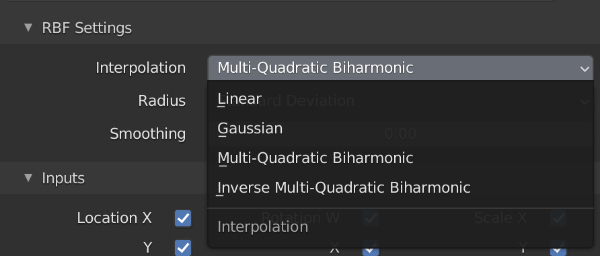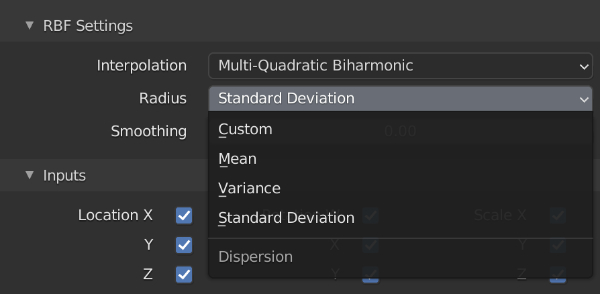RBF Settings
The RBF Settings section of the RBF Drivers panel is where you control how the selected RBF Driver interpolates between all your poses.

Interpolation
Each of the available interpolation types will change how closely the driven properties stick to the poses you have defined, as well as how smoothly and quickly they transition between then. You don't need to know how each of them works, you can simply select which one works best for you by switching between them and playing around in the viewport.

Linear
Linear interpolation will simply transition linearly between the poses based on the current inputs. The driven properties will remain very close to the defined poses. This works well when you want a very tight fit to your data points, particularly for smaller data sets.
Gaussian
The gaussian option will provide a smooth, bell-shaped curve, easing the transitions between poses in and out. It's often a good choice if your data points are somewhat scattered. You can affect the transition timing by changing the radius setting, or providing a custom radius for complete control.
Multi-Quadratic Biharmonic
Multi-quadratic biharmonic interpolation generally provides a nice median between the smooth characteristics of gaussian and strictness of linear and is the default setting. Your mileage may vary depending on your data set but it's usually my preferred option.
Inverse Multi-Quadratic Biharmonic
Inverse multi-quadratic biharmonic offers a slight variant on multi-quadratic biharmonic, pushing things a bit further at the ends.
Radius

Note
The radius setting will not show when interpolation is set to Linear
Mean
The radial basis function will use the average distance between all data points.
Variance
The radial basis function will use the variance of the distances between all data points.
Standard Deviation
The radial basis function will use the standard deviation between all data points. This is probably the most commonly used dispersion measure in RBF networks and the default for RBF Driver
Custom
By selecting a Custom radius, an input field will appear where you can input whatever radius you wish. You're unlikely to use this option unless you're familiar with your data set and how the interpolation functions work but feel to play around providing different values here to see the effect.
Note
When using a custom radius, each time you update the radius value the RBF network data needs to be recalculated and the drivers recreated. This is not a small task, and with complex drivers you may notice a slight lag in the interface when sliding the radius value.
Smoothing

Increasing the smoothing value will relax the fit of the driven properties to the poses, essentially increasing the visual effect of the interpolation. Under most circumstances the interpolation alone will provide pleasing results, but do play around with the smoothing to become familiar with its effect.
Note
Each time you update the smoothing value the RBF network data needs to be recalculated and the drivers recreated. This is not a small task, and depending on your system, with complex drivers you may notice a slight lag in the interface when sliding the smoothing value.